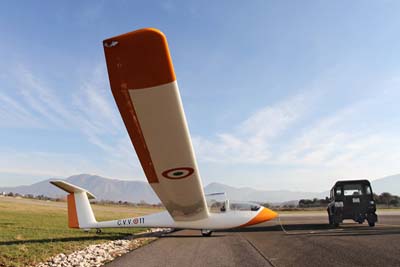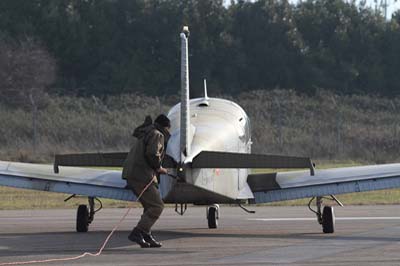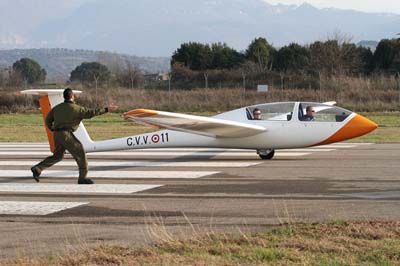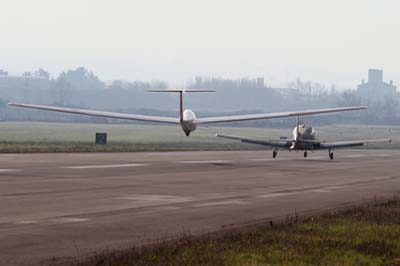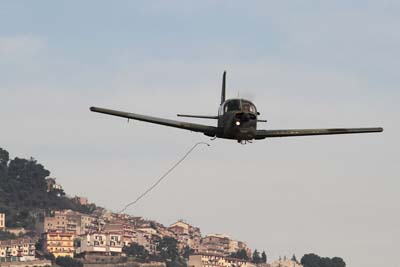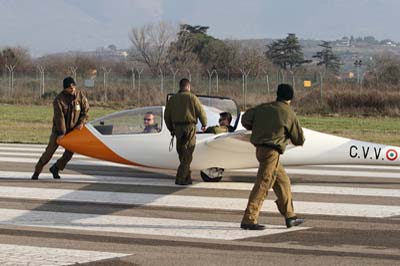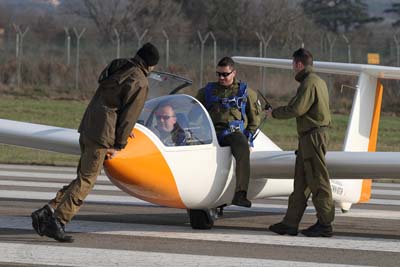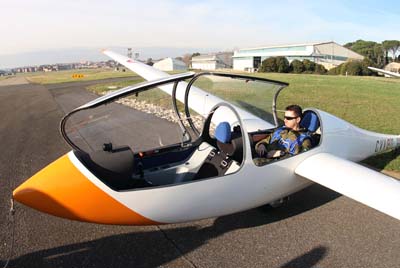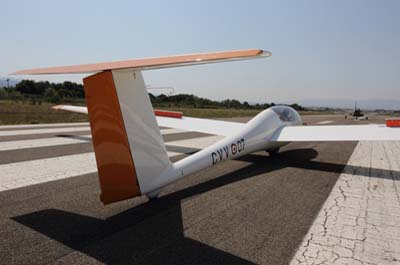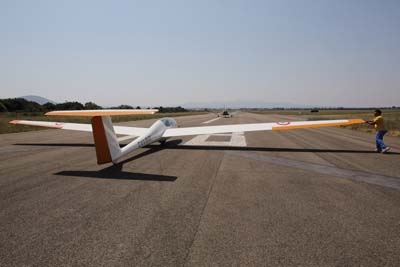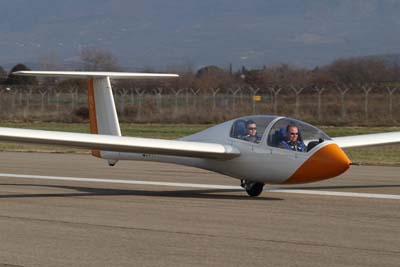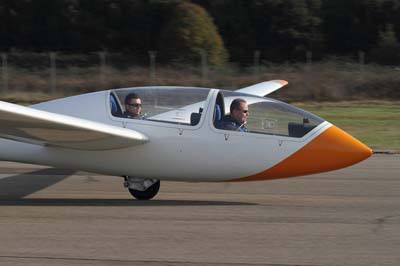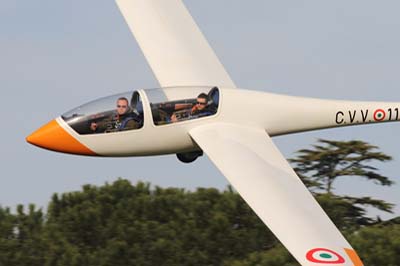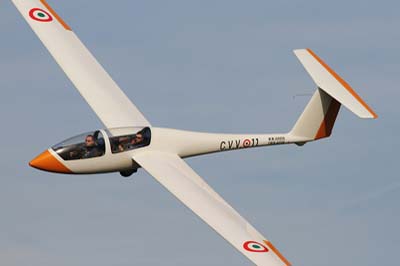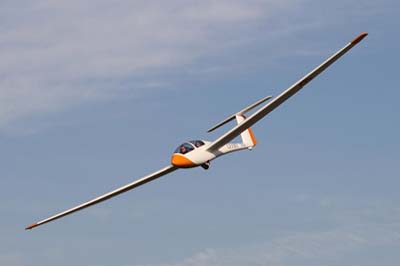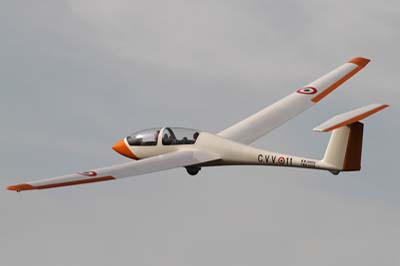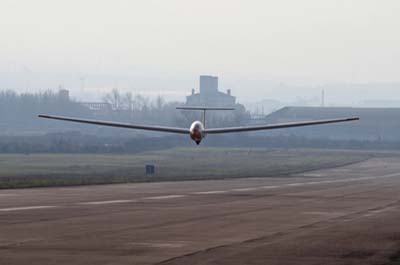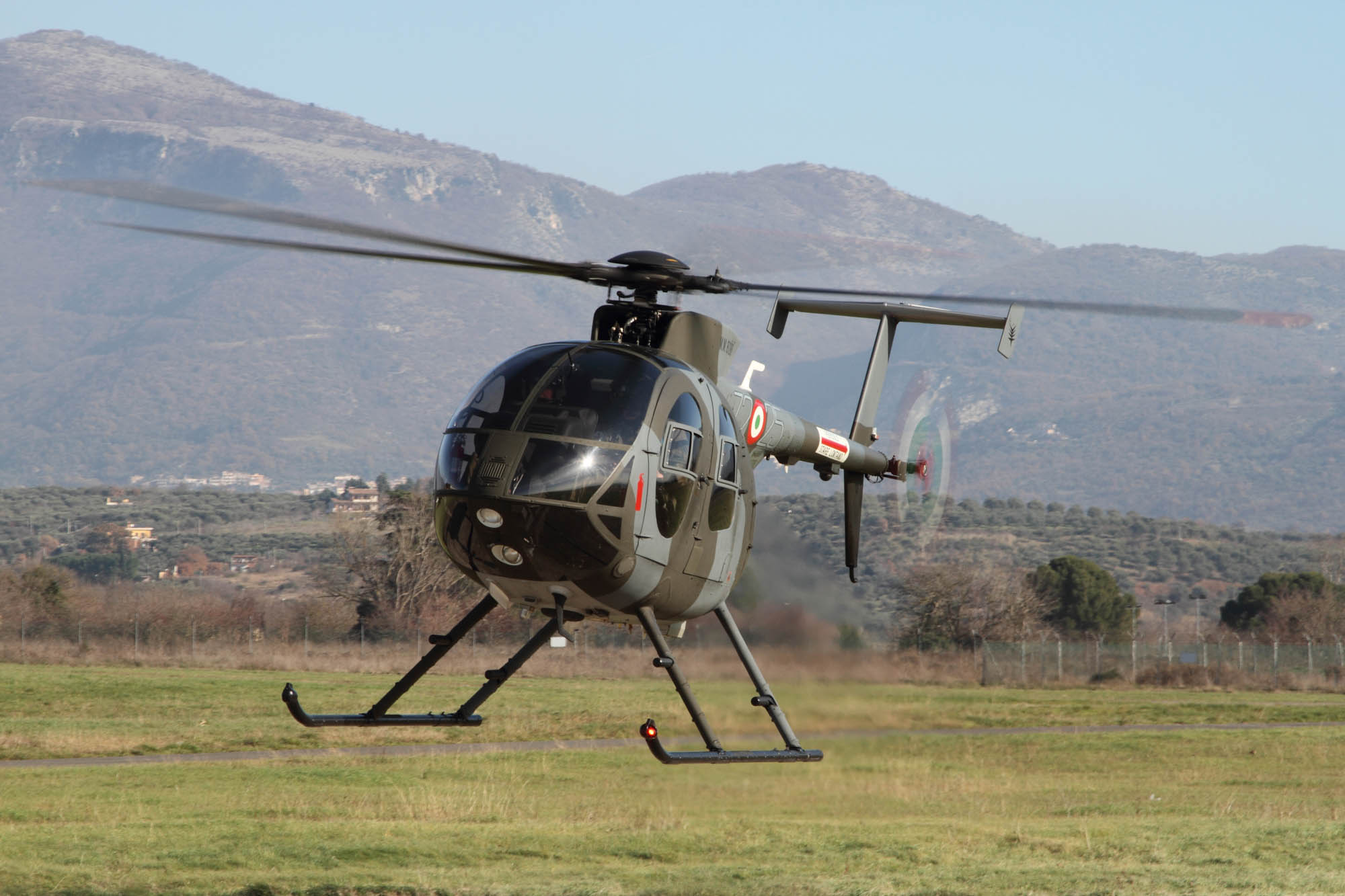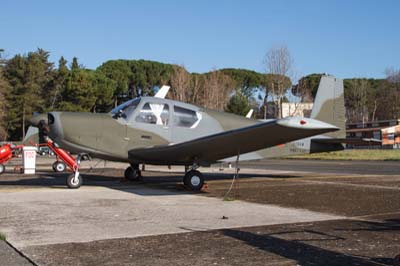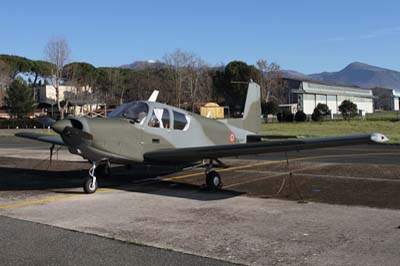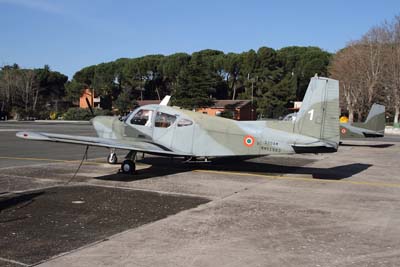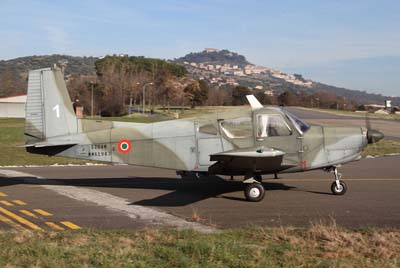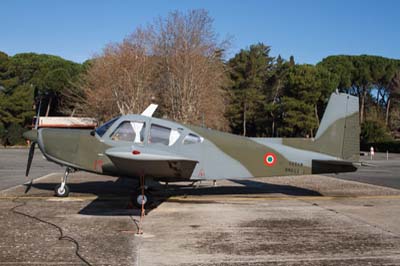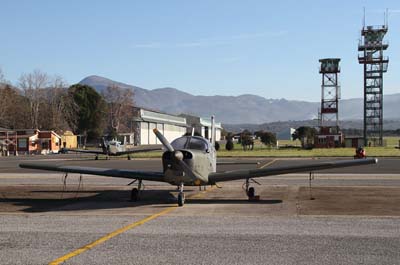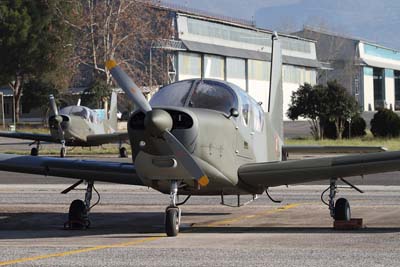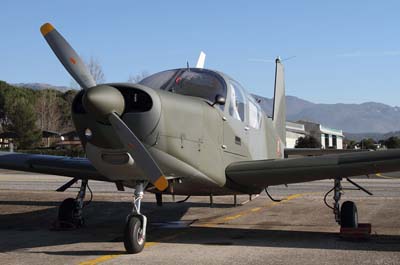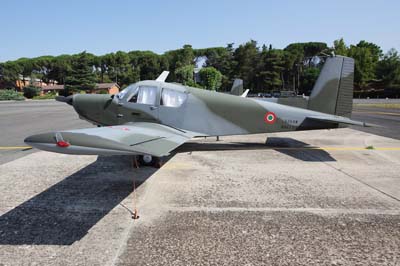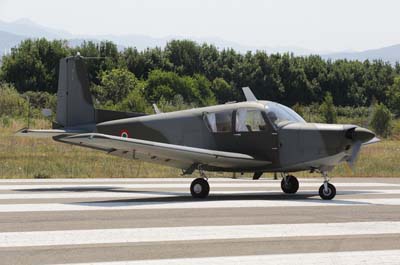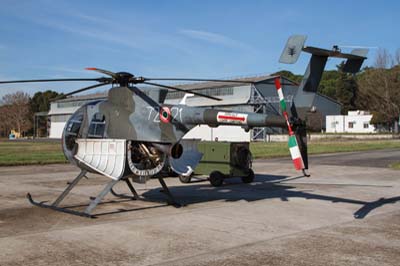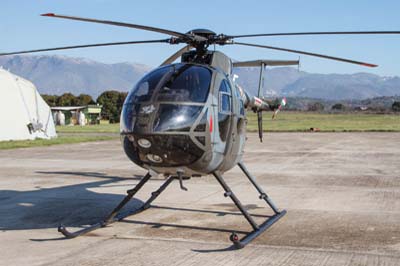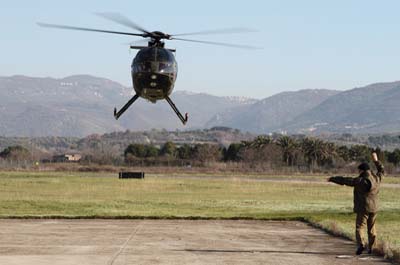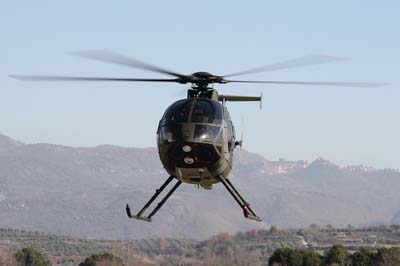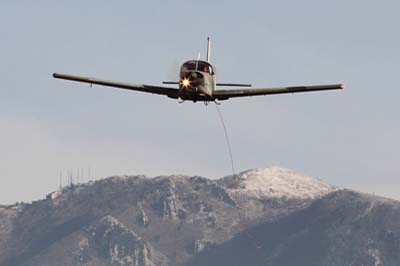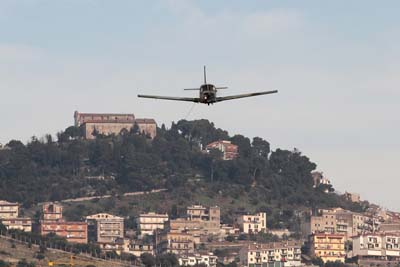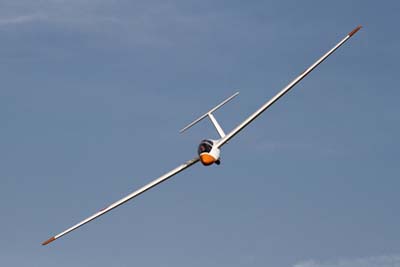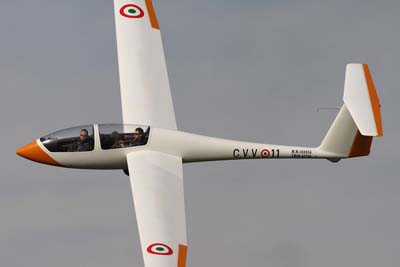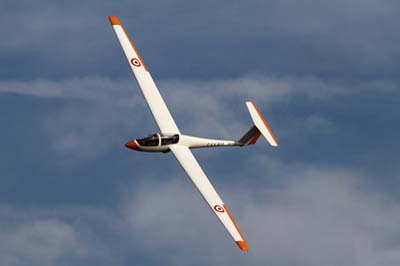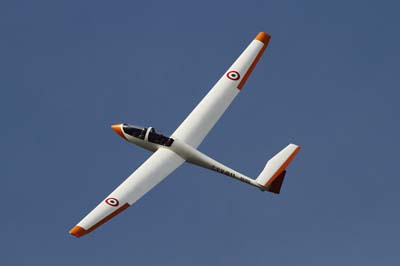Italian Air Force - Aeronautica Militare
Gliding Centre (Centro di Volo a Vela)
Guidonia-Montecelio Air Force Base
December 28-29, 2010
|
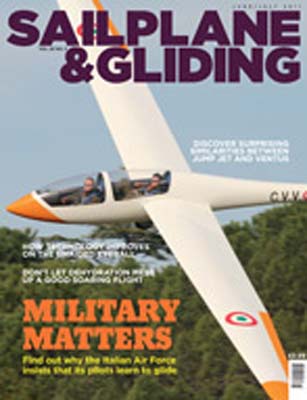 Major Filippo Zuffada, Commander of the Italian Air Force Gliding Centre at Guidonia-Montecelio, wants to combine his vast gliding experience with fresh ideas for the benefit of instructors and students.
Major Filippo Zuffada, Commander of the Italian Air Force Gliding Centre at Guidonia-Montecelio, wants to combine his vast gliding experience with fresh ideas for the benefit of instructors and students.
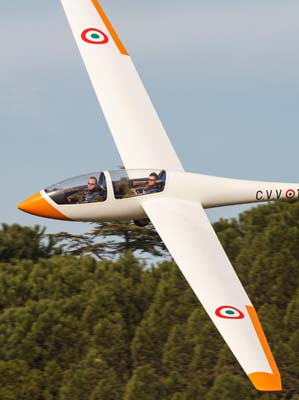 Philip Stevens reports for Sailplane and Gliding on the Italian Air Force's (Aeronautica Militare - AMI) Gliding Centre (Centro di Volo a Vela) is located at the historic airfield of Guidonia-Montecelio located to the north east of Rome. Here the AMI's potential plots are trained to fly gliders.
Philip Stevens reports for Sailplane and Gliding on the Italian Air Force's (Aeronautica Militare - AMI) Gliding Centre (Centro di Volo a Vela) is located at the historic airfield of Guidonia-Montecelio located to the north east of Rome. Here the AMI's potential plots are trained to fly gliders.
In November 2010 Major Filippo Zuffada returned Guidonia as the new Gliding Centre Commander. Maj. Zuffada was born in 1970 and at 20 joined the AMI for the four year flying training course. Following graduation he was posted to Decimomannu, Sardinia and for the next three years piloted helicopters for Search and Rescue operations. He later completed nine years at the Gliding Centre at Guidonia as an instructor pilot before transferring to 61st (Jet Training) Wing (61º Stormo, 213º and 214º Gruppo) at Lecce as an instructor on the Aermacchi MB-339A jet trainer. His varied flying experience totals around 1,000 hours on helicopters, 1,000 hours on gliders, 1,000 hours on single-engine propeller aircraft and 1,500 hours on jet aircraft. More remarkable and why he is a major inspiration to those under his command and to his students is that he has twice been runner-up in the annual Military World Gliding Championships the 'Campionato Mondiale Militare di Volo a Vela' for air force flying schools. He is a highly skilled glider pilot.
Major Zuffada is a firm believer that learning to fly a glider is very important for student pilots as it teaches them how to fly an aircraft and improve their general flying skills; "The glider pilot needs to use all the flight controls, especially the pedal rudder. When flying a powered aircraft, the pilot uses the rudder very little. You learn 'Energy Management' that is Altitude versus Speed." He added that the pilot has to be focused when flying a glider; "You don't have a second chance in a glider when in the approach, the pilot must have good parameters all the time." |
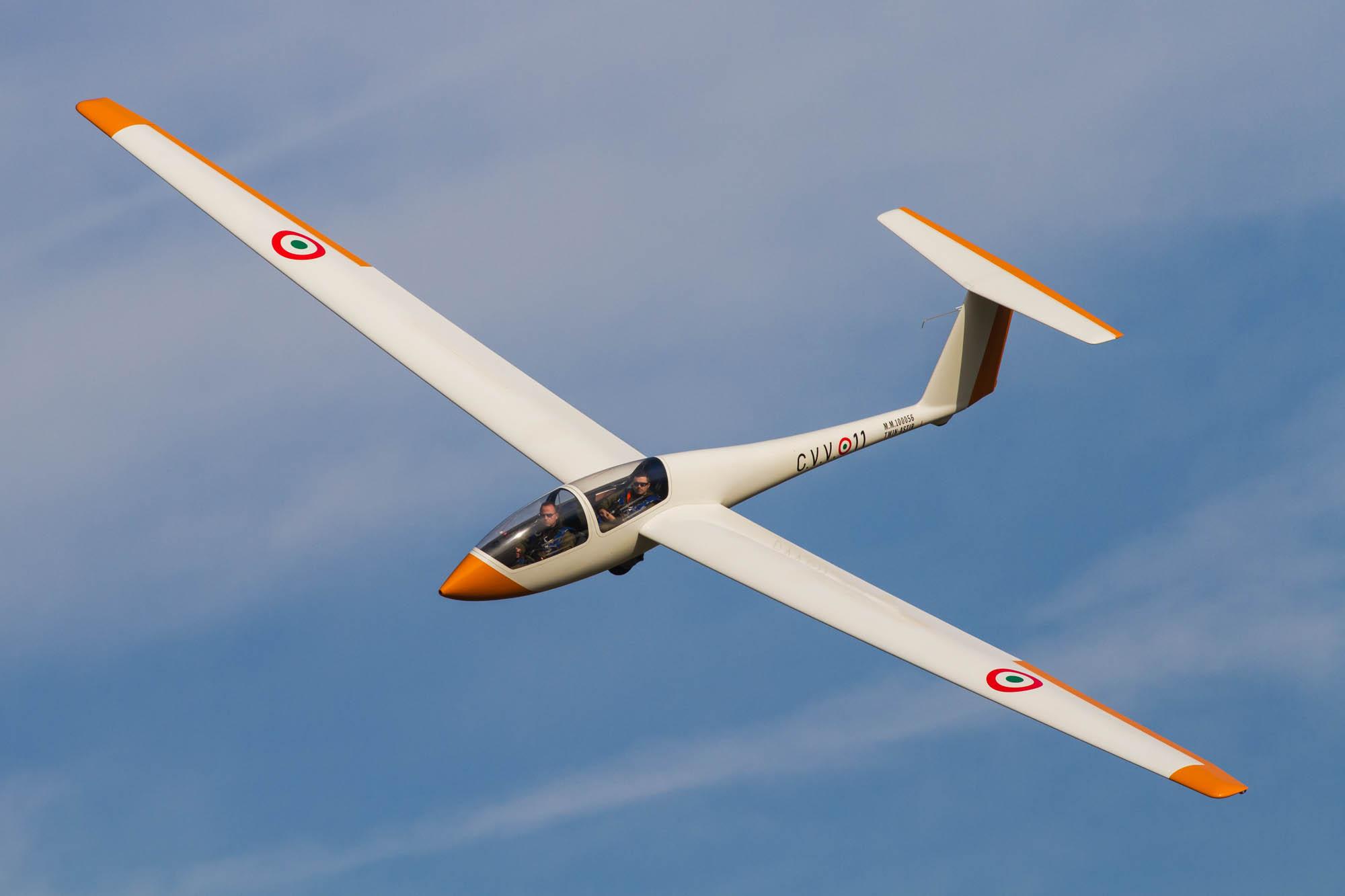 |
| Grob G.103A Twin Astir II (MM100056 'CVV-11') with Major Filippo Zuffada the new Gliding Centre Commander at the controls dives down on to the airfield. |
Guidonia an air field with a rich history
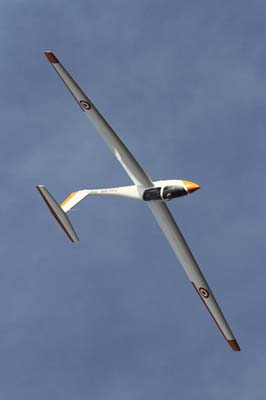 The Guidonia airfield is steeped in history, it is named after General Alessandro Guidoni who was killed when testing his own new design of parachute on April 27, 1928 in this area, he had lived in the nearby town of Montecelio. On the 7th anniversary of his death Duce, Benito Mussolini laid the founding stone of a military town and airfield named Guidonia which was to be constructed at the location of his tragic death. The airfield was used as a testing facility for the Italian Air Force and was equipped with a revolutionary wind tunnel and a large water tank to be used for testing sea planes up until the out brake of the World War Two. When the German forces were in retreat in 1944 these and other historic buildings were blown up, their ruined remains have been left untouched to this day as a memorial. The testing of aircraft continued here until the Experimental Flight Test Wing (Reparto Sperimentale Volo - RSV) moved to Pratica di Mare south of Rome at the end of the 1950s, leaving various training units to operate from the airfield. The General Staff approved the creation of a gliding centre in 1943 and by 1951 it had became part of the Italian Flying Club. The AMI Gliding Centre was formed and operated from Guidonia and Rieti from August 1959 utilising Canguro gliders and P.148 towing aircraft. In 1967 the new SIAI-Marchetti S.205 and also the SIAI-Marchetti S.208/M were delivered to the Centre. In 1976 two new gliders were introduced, the Caproni A21S Calif and the LET L13AC acrobatic Blaník to replace the now aging Canguro gliders. In 1984 the Grob G103A Twin Astir II arrived followed by the Schempp-Hirth Ventus 2B and the Schempp-Hirth Nimbus 4D in 1997. Recently 303º Gruppo with the Piaggio P.166M relocated to Pratica di Mare from Guidonia to leave the Gliding Centre as the only based flying unit.
The Guidonia airfield is steeped in history, it is named after General Alessandro Guidoni who was killed when testing his own new design of parachute on April 27, 1928 in this area, he had lived in the nearby town of Montecelio. On the 7th anniversary of his death Duce, Benito Mussolini laid the founding stone of a military town and airfield named Guidonia which was to be constructed at the location of his tragic death. The airfield was used as a testing facility for the Italian Air Force and was equipped with a revolutionary wind tunnel and a large water tank to be used for testing sea planes up until the out brake of the World War Two. When the German forces were in retreat in 1944 these and other historic buildings were blown up, their ruined remains have been left untouched to this day as a memorial. The testing of aircraft continued here until the Experimental Flight Test Wing (Reparto Sperimentale Volo - RSV) moved to Pratica di Mare south of Rome at the end of the 1950s, leaving various training units to operate from the airfield. The General Staff approved the creation of a gliding centre in 1943 and by 1951 it had became part of the Italian Flying Club. The AMI Gliding Centre was formed and operated from Guidonia and Rieti from August 1959 utilising Canguro gliders and P.148 towing aircraft. In 1967 the new SIAI-Marchetti S.205 and also the SIAI-Marchetti S.208/M were delivered to the Centre. In 1976 two new gliders were introduced, the Caproni A21S Calif and the LET L13AC acrobatic Blaník to replace the now aging Canguro gliders. In 1984 the Grob G103A Twin Astir II arrived followed by the Schempp-Hirth Ventus 2B and the Schempp-Hirth Nimbus 4D in 1997. Recently 303º Gruppo with the Piaggio P.166M relocated to Pratica di Mare from Guidonia to leave the Gliding Centre as the only based flying unit.
Today the Gliding Centre at Guidonia comprises 422 Squadriglia Collegamenti with Twin Astir II and Nimbus 4D gliders. The Twin Astir's are used by the students and Nimbus 4Ds for advanced and competition glider flying. Also here are the 423 Squadriglia Collegamenti with the S.208M which are used for glider towing. There are also two Guidonia based Breda-Nardi Hughes NH-500E helicopters belonging to the Helicopter Flight School (72º Stormo) at Frosinone. 208º Gruppo operate the NH-500E which are principally used for communications duties.
The unit has nine instructors all qualified on all three types of based aircraft. While their main activity is student glider pilot training, the instructors are also available for 'check-rides' for desk based officers at AMI headquarters in Rome who are required to maintain their currency as pilots. |
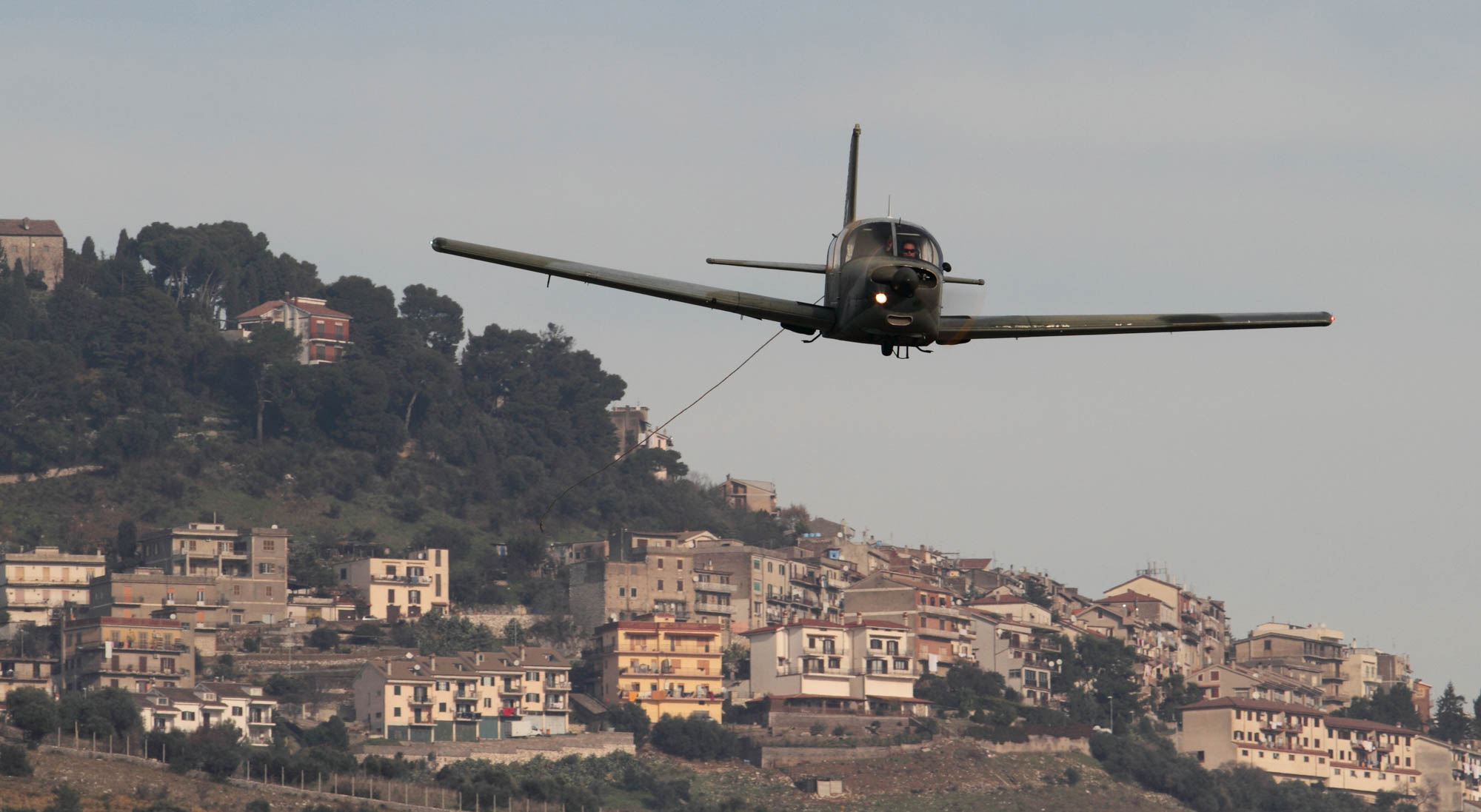 |
| SIAI-Marchetti S.208M (MM61983 '1') is about to drop the tow rope over the airfield. The town of Montecelio is in the background. |
Moving to Guidonia to fly gliders
From the end of January each year around 45 students arrive from the AMI Academy (Accademia Aeronautica) at Pozzuoli near Naples for the glider flying training course. Their first year would have been spent at Latina Air Base learning to fly (in around 18 hours) the SIAI-Marchetti SF.260 and where they will have gained their pilot’s wings. Of the original intake only around 60% of the students will make it to the second part of their military pilot training course at Guidonia. Here they should all attain their glider pilot wings before being offered one of three options to get their military pilot wings;
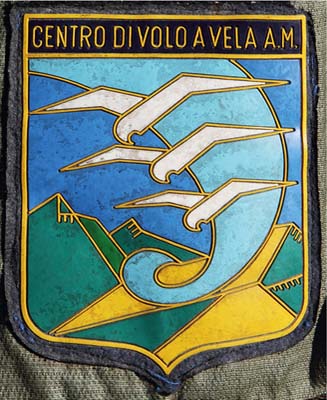
Option 1: return to Latina for the advanced propeller aircraft training course on the SF.260 and to then progress to Lecce Air Base to learn to fly the MB.339A jet trainer.
Option 2: transfer to the Rappresentanza Aeronautica Militare Italiana (RAMI) at Sheppard Air Force Base, Texas in the United States to learn to fly the T-6 Texan II before moving on to the Northrop T-38C Talon jet trainer also based at Sheppard AFB. In 1983 Italy became part of the Program Euro-NATO Joint Jet Pilot Training (ENJJPT) and under this program the facilities at Sheppard were made available to the AMI.
Option 3: transfer to RAMI at Kalamata Air Base in Greece to fly the Beechcraft T-6 Texan II before moving on to the MB.339 at Lecce. This ten month RAMI training course at Kalamata was set up in July 2009.
The AMI HQ Commander makes the decision as to which student takes which of the three options, the decision being based on the student’s proficiency in the preceding years.
An additional 70 students from the AMI Military School (Scuola Militare Aeronautica) at Florence will also attend the basic glider flying training course at Guidonia. These students are here to gain flying experience only and not to qualify as military pilots. |
| The gliders are towed to the runway by Land Rover and are connected to the SF.208M towing aircraft ready for launch. |
Learning to fly gliders
Following two weeks of ground training 15-20 students at a time are trained to fly gliders. For each student ten to twelve flights that total up to seven hours in duration are sufficient for them to earn their wings and fly solo. The flights are short perhaps only 25 minutes in duration, the instructor during each sortie will teach only basic flying manoeuvres. They will be towed to between 2,000 feet (610m) and 3,000 feet (914m) and released to make their way to the airfield for a landing. The S.208M will have already dived on to the airfield to release the tow line and have landed. The glider is immediately connected back to the towing aircraft ready for the next student. It is a very efficient system enabling as many students to fly in each session.
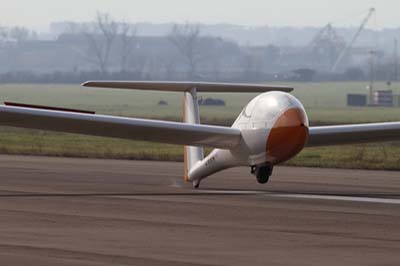 Typical of the nine instructor pilots based at Guidonia Captain Stefano Rotatori has for the last four years been an instructor on the Grob G.103A Twin Astir II. He is also an instructor on the S.208M and also on the NH-500E helicopter. Capt. Rotatori with the other instructors is determined to make sure each student passes the course. Although each student can have their own character he says, "80% of their mistakes are the same" he is seldom surprised he says, "You try to keep your hand from the stick for as long as possible before taking over. They must learn from their own mistakes."
Typical of the nine instructor pilots based at Guidonia Captain Stefano Rotatori has for the last four years been an instructor on the Grob G.103A Twin Astir II. He is also an instructor on the S.208M and also on the NH-500E helicopter. Capt. Rotatori with the other instructors is determined to make sure each student passes the course. Although each student can have their own character he says, "80% of their mistakes are the same" he is seldom surprised he says, "You try to keep your hand from the stick for as long as possible before taking over. They must learn from their own mistakes."
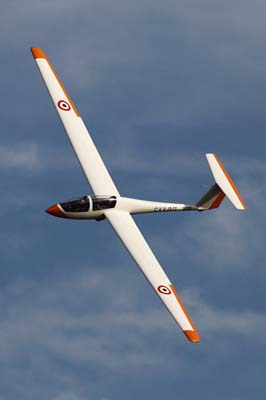 The gliding courses run until September each year, which is when the Squadron makes plans for their deployment to three air bases around Italy to provide flying experience for 16 to 20 year old students who are considering joining the AMI. The locations change each year, around 200 people at each place are given a week of lessons in aerodynamics followed by glider flying experience in their second week.
The gliding courses run until September each year, which is when the Squadron makes plans for their deployment to three air bases around Italy to provide flying experience for 16 to 20 year old students who are considering joining the AMI. The locations change each year, around 200 people at each place are given a week of lessons in aerodynamics followed by glider flying experience in their second week.
The original Grob G.103 Twin Astir is a two-seat sailplane which was designed and built in Germany in the 1970s with production continuing until 1980. The new improved design followed, designated the G.103A Twin II or Twin Astir II is flown by AMI students. It is of glass fibre construction with a non-retractable undercarriage and has upper wing surface airbrakes. It is designed for training, high performance and can be used for simple aerobatics. A strengthened variant designated the Viking TX.1 was later produced for the Royal Air Force Air Cadet training program. Eventually 549 G.103As (including 100 Viking TX.1s), were built before they were superseded by the G.103C Twin III in 1989.
Maj. Zuffada as the new Gliding Centre Commander wants to combine his vast gliding experience with fresh ideas for the benefit of his instructors and students. He hopes he can extend the glider flying program and also make contacts with other military gliding centres around Europe to arrange squadron exchanges. His first port of call is the RAF's own Air Cadets who fly similar gliders to his. Following his initial contact it appears that the RAF would be happy to participate in a two-way squadron exchange. I wish him and the Gliding Centre well and would like to thank them for the generous hospitality. |
Turn around is very quick during operations, they need to be as usually each flight lasts around 25 minutes and several gliders can be airborn at a time.
Left to right: A returning S.208M has just released the tow rope over the airfield. The G.103A Twin Astir II is turned around and the student and instructors take their seats for the next launch. |
| Turning downwind at speed over the airfield threshold the G.103A Twin Astir II (MM100056 'CVV-11') turns in to the wind to land. |
| G.103A Twin Astir II (MM100056 'CVV-11'). |
| Breda-Nardi Hughes NH-500E (MM81288 '72-25') about to touch down. |
| A gallery of the based aircraft |
| Left to right: SIAI-Marchetti S.208Ms (MM61935 and MM61983 '1'). |
| Left to right: SIAI-Marchetti S.208Ms (MM61980 and MM61936). |
| Left to right: SIAI-Marchetti S.208Ms (MM61936, MM61935 and MM61934). |
| Left to right: Breda-Nardi Hughes NH-500Es (MM81284 '72-21' and MM81288 '72-25'). |
| Left to right: SIAI-Marchetti S.208M (MM61983 '1') returning to the airfield after releasing a glider. |
| G.103A Twin Astir II (MM100056 'CVV-11'). |



